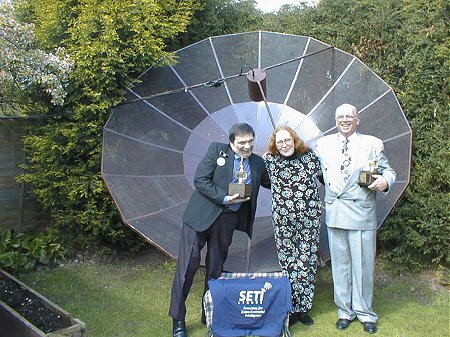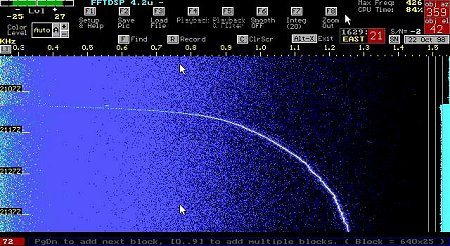
|
|
email Dr. SETI ® |
|
Prologue To SETI
Copyright © 2001 by H. Paul Shuch, Ph.D.
Excerpted from Tune In The Universe! (ARRL)

|
|
email Dr. SETI ® |
|
Ken's fingers flew over the keyboard, his eyes never leaving the monitor. "Frequency?" he asked.
"Fourteen seventy one point five," answered Trevor, tweaking the tuning dial on the Icom 7000 receiver. "It's steady at S2. I've marked the local sidereal time. Shall I ring up the BBC?"
"Are you daft, man? Let's not forget the verification protocols! Check for modulation, and be quick about it."
"It's CW -- no, there's sidebands. Looks kind of like modem tones. Low baud."
The two English radio amateurs and were manning their radio telescope, much as they had during every spare waking hour for the past three weeks, in search of an intelligent signal from the stars. As UK Co-Coordinators for Project Argus, the all-sky survey launched by The SETI League on Earth Day, April 21, 1996, their job was to assist other British hams in building sensitive microwave listening posts. Their 3.5 meter diameter dish and associated electronics were put together as a demonstration station, and now they were demonstrating the patience and deliberation for which their one hundred combined years had uniquely prepared them. They were systematically analyzing an anomaly.
![]() You can hear what Ken (G4KIR) and Trevor (G0ECP) were hearing by clicking on the speaker icon at left.
You can hear what Ken (G4KIR) and Trevor (G0ECP) were hearing by clicking on the speaker icon at left.
"Doppler's kind of high. Tens of Hertz per minute. I'm betting it's an LEO."
Ken's colleague knew that Low Earth Orbit satellites were the bane of SETI, the scientific Search for Extra-Terrestrial Intelligence. Fortunately, their Doppler shift, a change in radio frequency caused by their motion relative to the Earth, made such manmade sources readily distinguishable from signals of interstellar origin. Still, there was something odd about this particular signal...

A group of American microwave experimenters was not about to let the Search die for lack of intelligence in Washington. Ken and Trevor had heard about their amateur effort at the World Science Fiction Convention in Glasgow the previous summer, and were the first Europeans to sign on. Now their many months of effort and training were being put to the test.
"Save to disk," commanded Trevor unnecessarily, for Ken was already doing so. "Let's get a GIF, and also maybe a WAV file. We're going to have to Internet this one."
The signal amplitude rose smoothly, then fell. "Wow!" exclaimed Ken.
"Let's not be hasty," cautioned Trevor. "I think it's time to Ask Dr. SETI."
It was a moment of great excitement, for this "Wow!" event exhibited many of the characteristics we would expect of an intelligently generated microwave signal from space. Still, restraint was the order of the day. The experimenters sent their signal file to Dr. SETI (that's me.)
The signal looked for all the world to have originated from space, but its Doppler shift (that artifact of relative motion which makes railroad whistles and radio signals alike change in frequency over time) was suggestive of near space. This appeared to be a low Earth orbit satellite which Ken and Trevor had snared. Still, it was a worthy detection, for three reasons:
For their significant contributions to radio astronomy, our intrepid amateurs were the 1998 recipients of the Giordano Bruno Memorial Award, The SETI League's highest honor. Here you can see SETI League secretary Heather Wood presenting their trophies to Ken Chattenton (left) and Trevor Unsworth (right), in front of their modest backyard dish.

Presently, I showed an image of the candidate signal to a room full of radio astronomers at the National Radio Astronomy Observatory in Green Bank, WV, home to the world's first SETI search in 1960. One professional observer exclaimed, "You landed that one on 1470.5 MHz, didn't you?"
"How did you know that?" I asked, stunned.
"Oh, we've seen this baby before. She's a classified US Navy satellite."
"Can you tell me more about it?"
"Well, yes, I could," my colleague grinned, "but then I'd have to kill you."
Project Argus continues to detect likely candidate signals, and on analysis, all (so far) have had similarly prosaic explanations. But that doesn't lessen our members' excitement at participating in their peculiar brand of electronic archaeology. So far, all of our Argonauts have exhibited the restraint and professionalism which Ken and Trevor modeled for them early on. Still, there have been claims in the media, about once a year, that SETI has indeed detected the evidence we seek. Four times now The SETI League has had to go public with what most would view as disappointing news.
The first false claim we found it necessary to dispel was a simple matter of mistaken identity. The second involved a statement made at a scientific meeting and taken out of context. The third was a matter of a private email cross-posted to the wrong Internet list. These things happen, and are easily rectified. But when the EQ Pegasi Hoax reared its ugly head, even Dr. SETI began to have doubts.
Two and a half years into our search, an anonymous hacker broke into a private signal verification email list, and made claims of an extraordinary nature. He had, he alleged, detected clear, unambiguous evidence of extra-terrestrial intelligence, while using his employer's ten meter satellite dish after hours. He could not identify himself, he claimed, because that would put his job in jeopardy. But here were email attachments, images showing precisely the kinds of signals we were looking for! For three weeks, SETI League members around the world scrambled to test the claim.

Only, it was a total fabrication. The images posted were testimony to the power of our computer technology. However, it was not the capabilities of any signal analysis software which they demonstrated, but rather those of a graphics program called Paint Shop Pro. The images in question were a cut-and-paste masterpiece, all part of an elaborate hoax to discredit SETI.
And it almost worked. When the press ran stories of the powerful signals from the EQ Pegasi binary star system, detected by an amateur radio astronomer, the public ate it up. The SETI community was thrown into damage-control mode. We pointed out that science cannot be done anonymously, that a credible researcher owns his successes as well as his failures. We mentioned that an admitted hacker (he signed his emails 'anon1420') was more likely to plant a virus than to discover aliens. And we emphasized that these powerful, repeating signals from a nearby star system were seen by but one person, day after day, yet somehow eluded detection by dozens of dedicated radio astronomers around the world.
For that claim, we in SETI were labeled part of the Grand Cover-Up. It was suggested in the tabloids that some nefarious Government conspiracy was at work.
So yes; I admit it: I'm part of the Government conspiracy. I pay taxes.
Some day, we are confident, we are going to find a signal which can not be attributed to mundane causes. Of course, until it has been independently verified by other observers, it will remain simply an anomaly. But as Project Argus grows to its planned network of perhaps 5000 amateur radio telescopes worldwide, seeing in all directions at once, we will ultimately have the means to achieve the independent confirmation which credible science demands.
When will that happen? Not today, certainly. Probably not tomorrow, and perhaps not for a very long time. For SETI offers little satisfaction to he or she who demands instant gratification. But if we are persistent, and proficient, and extremely patient, we may some day find the proof we seek, that we are not alone in the vast cosmos.
The knowledge gained by the world's amateur SETIzens has the potential to change our perception of humanity's place in the universe. I invite you, like Ken and Trevor and thousands of other experimenters, to become a part of this exciting quest, and help to bring us one step closer to fulfilling our cosmic destiny.

|
Copyright © H. Paul Shuch, Ph.D.; Maintained by Microcomm this page last updated 14 June 2007 |
TOP |